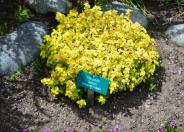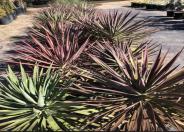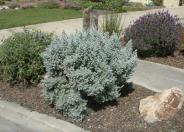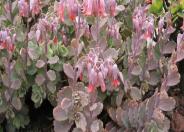
Common name:Golden Oregano
Botanical name:Origanum vulgare 'Aureum'
This attractive perennial is used as a ground cover since it reaches 1' high and spreads 1.5'. This plant prefers full sun in mild climates but will appreciate afternoon shade in hot summer areas. It does best in well draining, dry, sandy soil. This is the oregano herb plant with yellow green, aromatic, oval leaves. Tiny, pink/purple flowers rise above the foliage in summer on spikes but are considered insignificant. Leaves have culinary uses.

Common name:Magenta Magic Spanish Bayonet
Botanical name:Yucca aloifolia 'Magenta Magic'
Spiky upright lustrous mauve leaves make a dramatic garden statement! Reaching only 2-3’ tall and wide, this accidental sport of Yucca ‘Blue Boy’ is a natural dwarf variety with dark evergreen foliage that deepen to purplish mauve in cooler temperatures. 2-3’ tall spikes of white nodding flowers shoot above the foliage in late Winter on mature plants. Berries follow, much loved by birds, but ignored by deer. Tough and durable, it can take heat, dry conditions and a fair amount of neglect. Makes a dramatic statement when planted en masse and combines well with other dry garden denizens. An excellent container plant. Plant in well-drained soil.

Common name:Cushion Bush
Botanical name:Leucophyta brownii
Cushion Bush is a low mounding shrub that grows 1-3' tall and 2-3' wide. It has tiny, narrow, silver green foliage that makes it an outstanding accent plant. Tiny yellow flowers appear on the end of the stems in spring and summer. This plant does well in full to part sun with minimal water. It tolerates coastal and windy conditions well. If regularly pruned, this shrub will maintain its density and longevity. It does best in well draining soil. Be careful not to overwater.

Common name:Lavender Scallops
Botanical name:Kalanchoe fedtschenkoi
Kalanchoe fedtschenkoi is a low-growing perennial succulent with pretty flowers and compact foliage. The name of the plant honors botanist Boris Fedtschenkoi and is now known as Bryophyllum fedtschenkoi. Native to Madagascar, the plant belongs to the Crassulaceae family of plants and the genus Bryophyllum. Since its introduction to North America, it’s established itself in parts of the southern United States. It’s a relatively easy succulent to grow as a houseplant and it makes a great ground cover in suitable climates. You may hear it called by its common name including:
Lavender Scallops
Kalanchoe Stonecrop
South American Air Plant
Gray Sedum
Variegated Lavender Scallops
Kalanchoe fedtschenkoi ‘Variegata’ is a short, shrubby succulent typically reaching 1? – 2? feet tall. It features stems which spread out from the root along the ground, forming large colonies of thick succulent leaves. The blue-green leaves have cream-colored variegation along scalloped edges. The edges may turn red or pink under strong sunlight or drought conditions. The fleshy foliage is often darker green toward the center and trimmed with lavender. Each leaf may reach up to 2? inches and feature two to eight teeth around the edges. The stems are smooth and bendable. When the stems reach the ground, they may take root and grow new plants. In the late spring to early summer, the plant produces small bell-shaped flowers. The flowers hang loosely from upright stems. The loose clusters of flowers are often reddish-brown and only reach about 3/4-inch in size. Each flower has a short calyx and a slightly longer corolla. The plant is winter hardy in (USDA Zones) hardiness zone 9b or warmer. Outside of these areas, it’s typically grown indoors as a houseplant. It can tolerate temperatures below freezing for short periods. If temperatures regularly drop below 25° degrees Fahrenheit (-4° C), bring it indoors for the winter. The plant needs lots of strong sunlight (preferably full sun), whether grown indoors or outside, especially during the summer. Use porous soil with fast drainage to help prevent over-watering and mold growth. To make regular potting soil more porous, add sand or perlite. Lavender scallops require transplanting every few years. Transplanting allows you to replace the old soil with fresh soil and move up to a larger pot if necessary. When repotting, use caution around the leaves. The leaves are a little brittle and may snap when handled. When grown inside, place it near a south-facing or west-facing window.
Designer: Cricket Riley
Photographer: Vicki Anderson
Maintain a two to four inch layer of mulch on the soil surface to reduce weeds, infiltrate rain water, and reduce compaction.
Attract, or buy beneficial insects such as ladybugs and lacewings to control pest outbreaks in your garden.